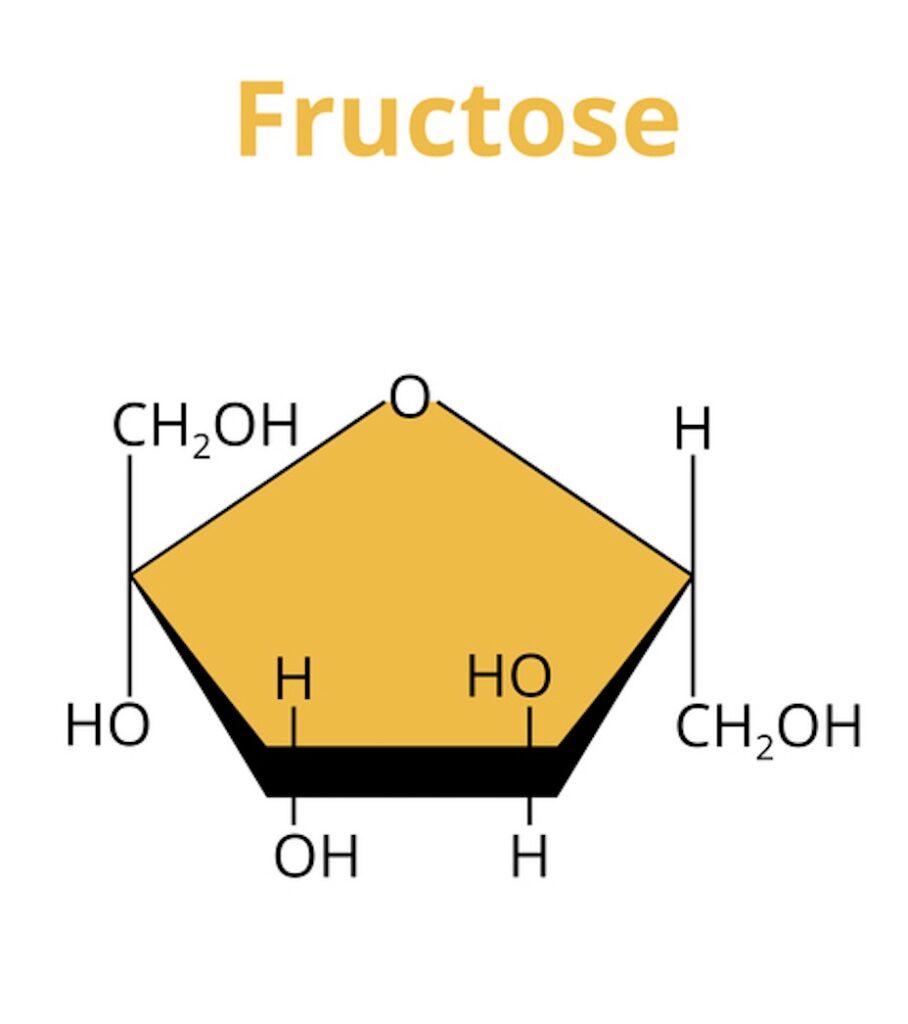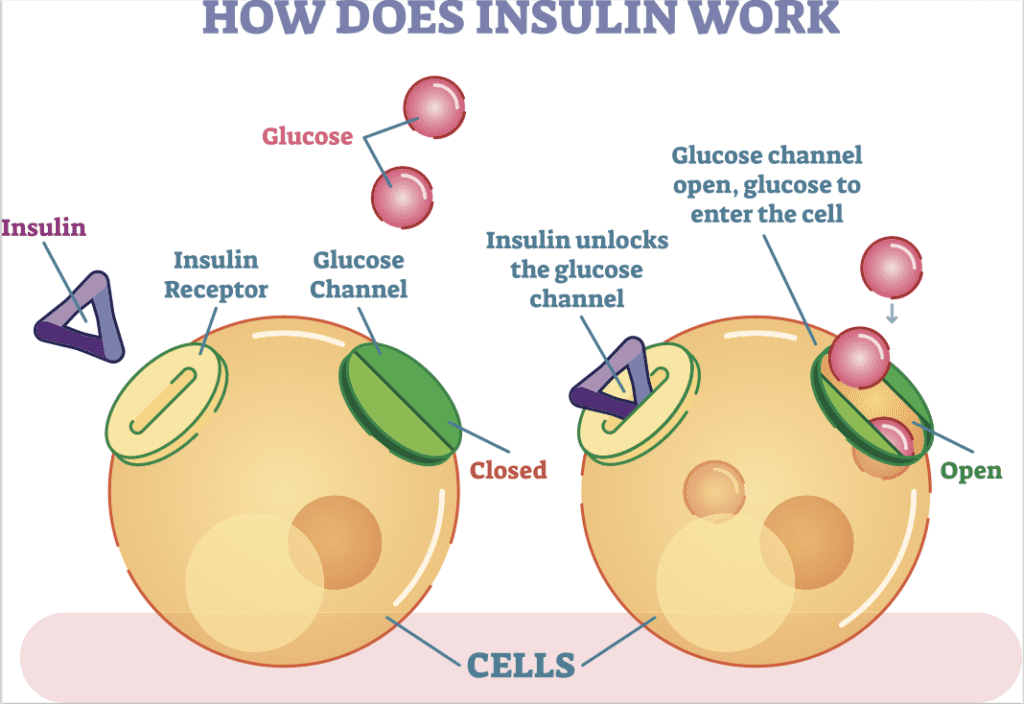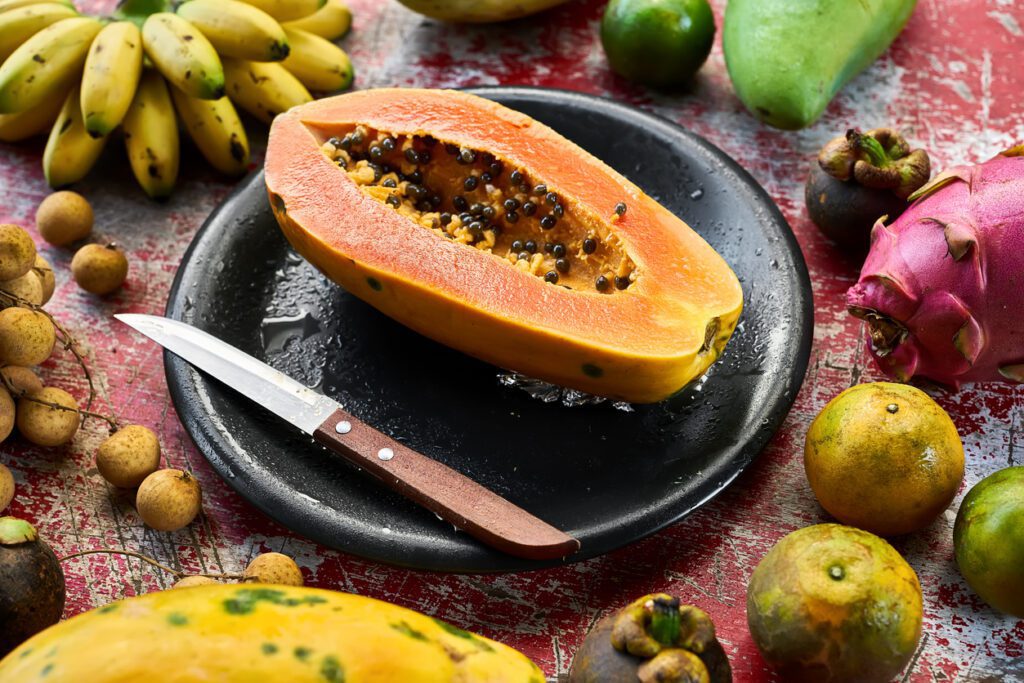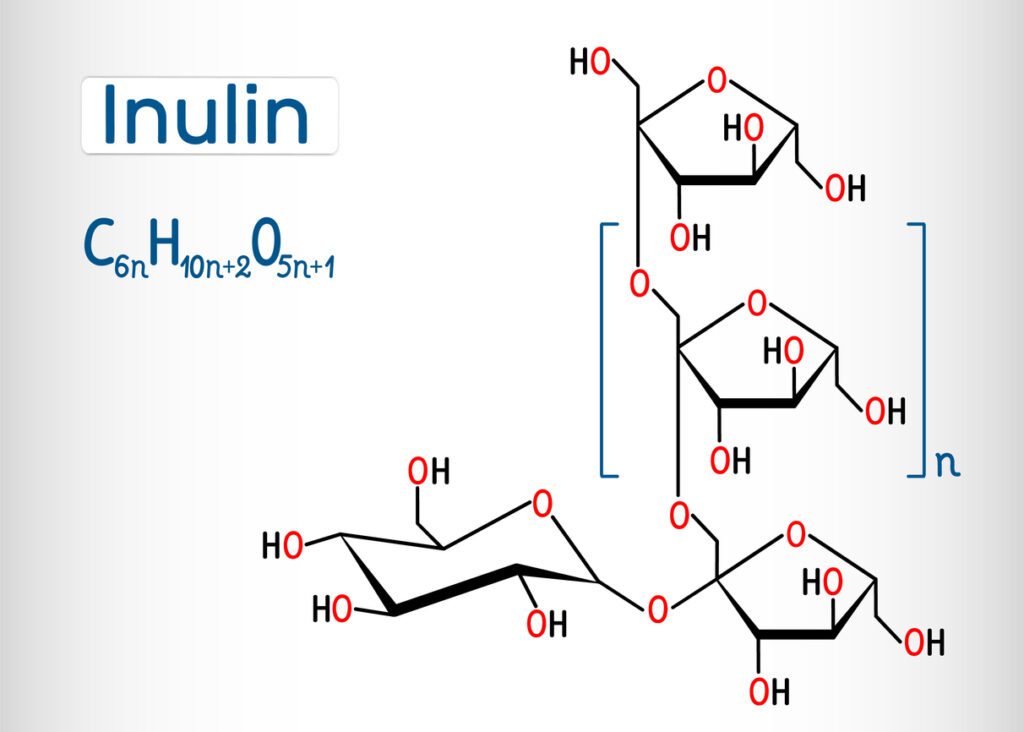Fructose – the simple sugar found in fruits and honey – is possibly the most underrated and misunderstood energy source for our cells. Learn how fructose from natural sources, particularly fruits, is actually one of the healthiest energetic nutrition for humans!
Fructose from fruits is healthy – but isolated fructose is not.
Due to studies on obesity and health impacts of isolated fructose in high-fructose syrups – and constant media attention and incomplete information – most of us now associate fructose with all kinds of diseases.
Lately, it turns out that fructose from natural sources – fruits – is highly beneficial for health. From increased energy to feeding the microbiome: we need to stop seeing natural sugars as an enemy! Carbs are energetic nutrition. Without sugar, there is no life! Like with all foods and nutrients, we need to get the right type and amount and stick to the natural foods that we have evolved to eat.
The consensus in nutrition science is that whole fruits are health-promoting, which comes as no surprise to the natural health community and people with common sense.

Fructose in fruits has a different health effect than food products containing highly processed and isolated fructose! For example, fructose from fructose syrup disrupts the intestinal microbiome, while fructose in fruit (inulin and other fructans) feeds our beneficial bacteria!
The evolutionary perspective is in line with this consensus and is also nothing short in surprise when explaining why fruits are so healthy for us:

Humans are anatomically and physiologically specialized in fruit-eating and thus fruits are the foods we have evolved with and adapted to eat!
Like most primates, including chimpanzees, humans are biological frugivores!
As frugivores, we just have a sweet tooth but often no access to ripe, flavorful tropical fruits. Colorful candies are an unhealthy substitute for sweet, colorful tropical fruits, which we crave.
And if you heard that wild fruits are different from modern cultivated fruits: yes, they are, but probably not in the way you think! Wild tropical fruits – the food source of wild primates – contain even more fructose than cultivated fruits!
“Humans clearly come from an evolutionary past in which hexose (fructose) – rather than sucrose-dominated fruits were consumed, and human digestive physiology should, therefore, be best adapted to a carbohydrate substrate similar to that of wild fruits. But, in addition, wild fruits differ in other respects from their cultivated counterparts. These include a high content of roughage – woody seeds, fibrous strands – as well as higher average protein levels, higher levels of many micronutrients … and , at times, considerable pectin.”
Kathrine Milton; 1999
Read here more on why fruits are a superior source of carbs than grains.
What is fructose, and how does it work in our cells?
Fructose is a simple sugar (a hexose) found naturally in fruits, but also vegetables, and honey.
The breaking down (metabolization) of fructose molecules generates ATP, the universal energy carrier for cells.

What is the process of transport of fructose into cells?
Cells can take up fructose with several members of the GLUT transporter family. But fructose is mainly transported by GLUT5 transporter, which exclusively imports fructose, not glucose. Those transporters let fructose pass across cell membranes passively into cells – they are basically open doors for fructose!
Unlike glucose transporters (see image below), the fructose transporter GLUT5 is insulin-independent. It is expressed in many types of tissues (see below), which means that fructose can enter various cell types of the body and readily deliver the energy for our metabolism without the production of insulin! This is one reason why fruits and fructose are interesting for people with insulin issues as a source of energy.

Once inside the cell, fructose can be used by the cell via fructolysis (similarly to glycolysis) to produce energy, which ultimately powers all energy-dependent processes within the body! Fructose can also be transformed and stored in the form of glycogen for later use if there is not an immediate need for the energy.
In what type of cells is fructose used?
The belief that fructose is exclusively taken up and metabolized by the liver is outdated. We now know that many types of cells express the GLUT5 transporter to obtain fructose for energy. First, fructose is taken up by the small intestine. Kidneys, brain, skeletal muscles, and fat cells use fructose for their metabolism. Fructose is efficiently absorbed and utilized in particular by
- muscle cells
- adipose tissue cells (fat cells)
- hepatocytes (liver cells)
- renal proximal tubular epithelial cells (kidney)
- intestinal enterocytes
- pancreatic beta cells
- several types of brain cells
Fructose uptake (the expression of GLUT5) depends on species, age, and health. And, as frugivorous species, humans absorb and use fructose by many cell types – a characteristic that has likely evolved as an adaptation to the consumption of fructose-rich food (fruits!) as the main part of the natural diet. As a result, fructose from fruits has become an important energy source for many tissues of humans. Fructose can be used to produce ATP (adenosine triphosphate), which is the main form of energy used by cells in the body. Thus, fructose is a vital source of energy for many cells.
How does fructose help the body to function?
Fructose has been found to play an important role in the regulation of blood sugar levels, energy metabolism, and lipid metabolism. Therefore, it is essential that cells are able to absorb and use fructose efficiently for the proper functioning of the body.
Here are some of the benefits from fructose in fruits:
- Easily available energy source: Fructose serves to provide energy for the body as it is broken down into glucose, which can be used by cells for metabolic processes. As easy energy, fructose enables all energy-requiring cell activities.
- Less tasking to the pancreas: Because fructose does not trigger insulin production, the pancreas gets a break!
- Intestinal nutrient absorption: Fructose aids the absorption of certain vitamins and minerals in the intestine, like iron.
- Microbiome health: Fructose (oligo-fructose “fructan“) from fruit promotes healthy digestion by providing essential dietary fibers and food for the microbiome that help to break down food and absorb nutrients.
- Avoids insulin and blood sugar spikes: Fructose is less likely to cause less oxidative damage in cells compared to other sugars, such as glucose, because of insulin independence.
- Cellular communication: Fructose is involved in cell signaling.
- Helps regenerate and protect cells: Fructose provides protection against cell damage caused by environmental stressors such as ultraviolet radiation and toxic chemicals.
How is fructose from fruits helpful for people with insulin problems?
Fructose from fruit is an energy source for people with insulin problems. Unlike other simple sugars, it does not raise blood glucose levels and can be digested without the need for insulin.
This makes it a great option for those who require careful regulation of their blood sugar levels due to diabetes or other health concerns. Fruits also provide essential vitamins and minerals, making them a valuable source of nutrition. Additionally, the consumption of fruit can reduce hunger and cravings for sweet foods.
All these factors make fructose from fruits (not isolated fructose!) an ideal energy source for people with insulin problems.
Fructose feeds beneficial gut bacteria
Polysaccharides are strands of linked sugar molecules (mostly fructose) found in fruits and vegetables. We also know them as fibers, oligofructoses, or “fructans”! Those short chains of sugars are not digested by us but by our gut bacteria: Fructans are fermented by the microbiome and, in particular, boost the growth of beneficial bifidobacteria populations (Flamm et al., 2001).

Inulin and other fructans are two prominent prebiotics (food for probiotic bacteria), which are mainly found in fruits! Inulin has been shown to balance the microbiome by increasing beneficial and decreasing harmful bacteria populations (Hoffman et al., 2019). Fructans, in general, improve the profile of intestinal bacteria, as well as mucosa health (tight junctions) (Liu et al., 2016).

Inulin is one of many types of polysaccharides: the strand is made up of multiple fructose molecules in a row and one glucose molecule in the end. Fructans are only one of many beneficial compounds of naturally occurring fructose – and fruits, in general, have multiple restorative effects on the microbiome!
Are there any risks associated with high levels of fructose intake?
There are risks associated with high levels of fructose intake, but only if fructose is isolated: a high intake of added sugars, including isolated fructose, has been linked to numerous health issues such as weight gain, type 2 diabetes, metabolic syndrome, and cardiovascular disease. Long-term consumption of high amounts of fructose can also lead to fatty liver disease due to its effect on increasing sugar levels in the body.
However, when eating a high-fruit diet, too much fructose from natural sources is not a thing! What seems like a no-brainer is also supported by research on the effects of fruits on health, even in people with insulin issues. If you still have doubts, ask a chimpanzee : ) or read our article on fruits and insulin resistance.
References
- Jang, C. et al. (2018) ‘The small intestine converts dietary fructose into glucose and organic acids’, Cell Metabolism, 27(2). doi:10.1016/j.cmet.2017.12.016.
- Fructan (2023) Wikipedia. Wikimedia Foundation. Available at: https://en.wikipedia.org/wiki/Fructan (Accessed: April 4, 2023).
- Milton, K. (1999) “Nutritional characteristics of wild primate foods: Do the diets of our closest living relatives have lessons for us?,” Nutrition, 15(6), pp. 488–498. Available at: https://doi.org/10.1016/s0899-9007(99)00078-7.
- Merino, B. et al. (2019) ‘Intestinal fructose and glucose metabolism in health and disease’, Nutrients, 12(1), p. 94. doi:10.3390/nu12010094.
- Douard V, Ferraris RP. Regulation of the fructose transporter GLUT5 in health and disease. Am J Physiol Endocrinol Metab. 2008 Aug;295(2):E227-37. doi: 10.1152/ajpendo.90245.2008. Epub 2008 Apr 8. PMID: 18398011; PMCID: PMC2652499.
- Biochemistry, fructose metabolism – statpearls – NCBI bookshelf (no date). Available at: https://www.ncbi.nlm.nih.gov/books/NBK576428/ (Accessed: April 4, 2023).
- Douard, V. and Ferraris, R.P. (2008a) ‘Regulation of the fructose transporter GLUT5 in health and disease’, American Journal of Physiology-Endocrinology and Metabolism, 295(2). doi:10.1152/ajpendo.90245.2008.
- Hundal, H.S. et al. (1998) “GLUT5 expression and fructose transport in human skeletal muscle,” Advances in Experimental Medicine and Biology, pp. 35–45. Available at: https://doi.org/10.1007/978-1-4899-1928-1_4.
- Taylor, S.R. et al. (2021) “Dietary fructose improves intestinal cell survival and nutrient absorption,” Nature, 597(7875), pp. 263–267. Available at: https://doi.org/10.1038/s41586-021-03827-2.
- Briden, L. (2022) High-dose fructose can cause or worsen insulin resistance (but fruit is okay), Lara Briden – The Period Revolutionary. Available at: https://www.larabriden.com/quit-sugar-and-what-i-mean-by-sugar/ (Accessed: April 4, 2023).
- Flamm, G. et al. (2001) ‘Inulin and oligofructose as dietary fiber: A review of the evidence’, Critical Reviews in Food Science and Nutrition, 41(5), pp. 353–362. doi:10.1080/20014091091841.
- A. K. Sharma et al., Traditional human populations and nonhuman primates show parallel gut microbiome adaptations to analogous ecological conditions. mSystems. 5 (2020), doi:10.1128/msystems.00815-20.
- Hoffman, J.D. et al. (2019) ‘Dietary inulin alters the gut microbiome, enhances systemic metabolism and reduces neuroinflammation in an APOE4 mouse model’, PLOS ONE, 14(8). doi:10.1371/journal.pone.0221828.
- Liu, T.-W. et al. (2016) ‘Nondigestible fructans alter gastrointestinal barrier function, gene expression, histomorphology, and the microbiota profiles of diet-induced obese C57BL/6J MICE’, The Journal of Nutrition, 146(5), pp. 949–956. doi:10.3945/jn.115.227504.
- Li, M. et al. (2014) “Fruit and vegetable intake and risk of type 2 diabetes mellitus: Meta-analysis of prospective cohort studies,” BMJ Open, 4(11). Available at: https://doi.org/10.1136/bmjopen-2014-005497.


Add Comment